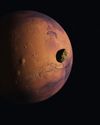
When NASA’s Cassini spacecraft flew past Rhea, Saturn’s second-largest moon, it detected an unexpected and puzzling change in the ultraviolet radiation reflected from its surface. The data from Cassini’s flybys has led to a range of speculation and possibilities. Dr Amanda Hendrix, an expert in ultraviolet spectroscopy of planetary surfaces at the Planetary Science Institute in California, said that they noticed a dip in the spectrum and wondered if it was caused by some type of water ice. It was certainly an intriguing puzzle.
The signal was detected by the Cassini craft that was launched from Cape Canaveral on 15 October 1997. After seven years of travel it reached Saturn on 1 July 2004, and in total it orbited the planet for over 13 years. When it became very low on fuel it was decided to end the mission, and to avoid biological contamination of the planet or its moons it was deliberately sent into Saturn’s atmosphere, where it burnt up on 15 September 2017.
Cassini is one of the largest ever interplanetary probes to be built, weighing 2,150 kilograms. It carried the European Space Agency’s (ESA) Huygens lander probe, which it sent towards Titan, Saturn’s largest moon, on 25 December 2004. After 21 days of travel Huygens finally entered Titan’s atmosphere on 14 January 2005, and once on its frozen surface it transmitted data for 72 minutes until Cassini went out of range.
Denne historien er fra Issue 116-utgaven av All About Space.
Start din 7-dagers gratis prøveperiode på Magzter GOLD for å få tilgang til tusenvis av utvalgte premiumhistorier og 9000+ magasiner og aviser.
Allerede abonnent ? Logg på
Denne historien er fra Issue 116-utgaven av All About Space.
Start din 7-dagers gratis prøveperiode på Magzter GOLD for å få tilgang til tusenvis av utvalgte premiumhistorier og 9000+ magasiner og aviser.
Allerede abonnent? Logg på

MYSTERIES OF THE UNI WHERE ARE ALL THE SPIRAL GALAXIES?
There are far fewer spiral galaxies than elliptical ones in the Supergalactic Plane, and scientists are keen to discover why

ZOMBIE STARS
+10 OTHER TERRIFYING SPACE OBJECTS

HOW TO BEAT LIGHT POLLUTION
Thought it was impossible to observe the wonders of the night sky from towns and cities? Think again. Follow our tips and tricks on successfully observing through sky glow

15 STUNNING STAR CLUSTERS
These beautiful stellar groupings are spattered across the cosmos

Eileen Collins "It was a difficult mission...we were the first to see Mir"
Having served as both the first female pilot and first female commander of NASA's Space Shuttle, Collins boosted the involvement of women in space exploration to a whole new level

MARS LEAKS FASTER WHEN IT'S CLOSER TO THE SUN
The Red Planet has lost enough water to space to form a global ocean hundreds of kilometres deep

FUTURE TECH KANKOH-MARU
This ambitious reusable spacecraft will be capable of taking 50 people to and from orbit

THE FINAL FRONTIER
Beyond the reach of the Sun is a fascinating region of the cosmos that were only just beginning to explore

A long-lost moon could explain Mars' weird shape and extreme terrain
A long-lost moon could explain why Mars is so different from the other rocky planets in the Solar System. Today Mars has two tiny moons.

A sprinkling of cosmic dust may have helped kick-start life on Earth
Cosmic dust may have helped kick-start life on Earth. New findings challenge a widely held assumption that this wasn't a plausible explanation.